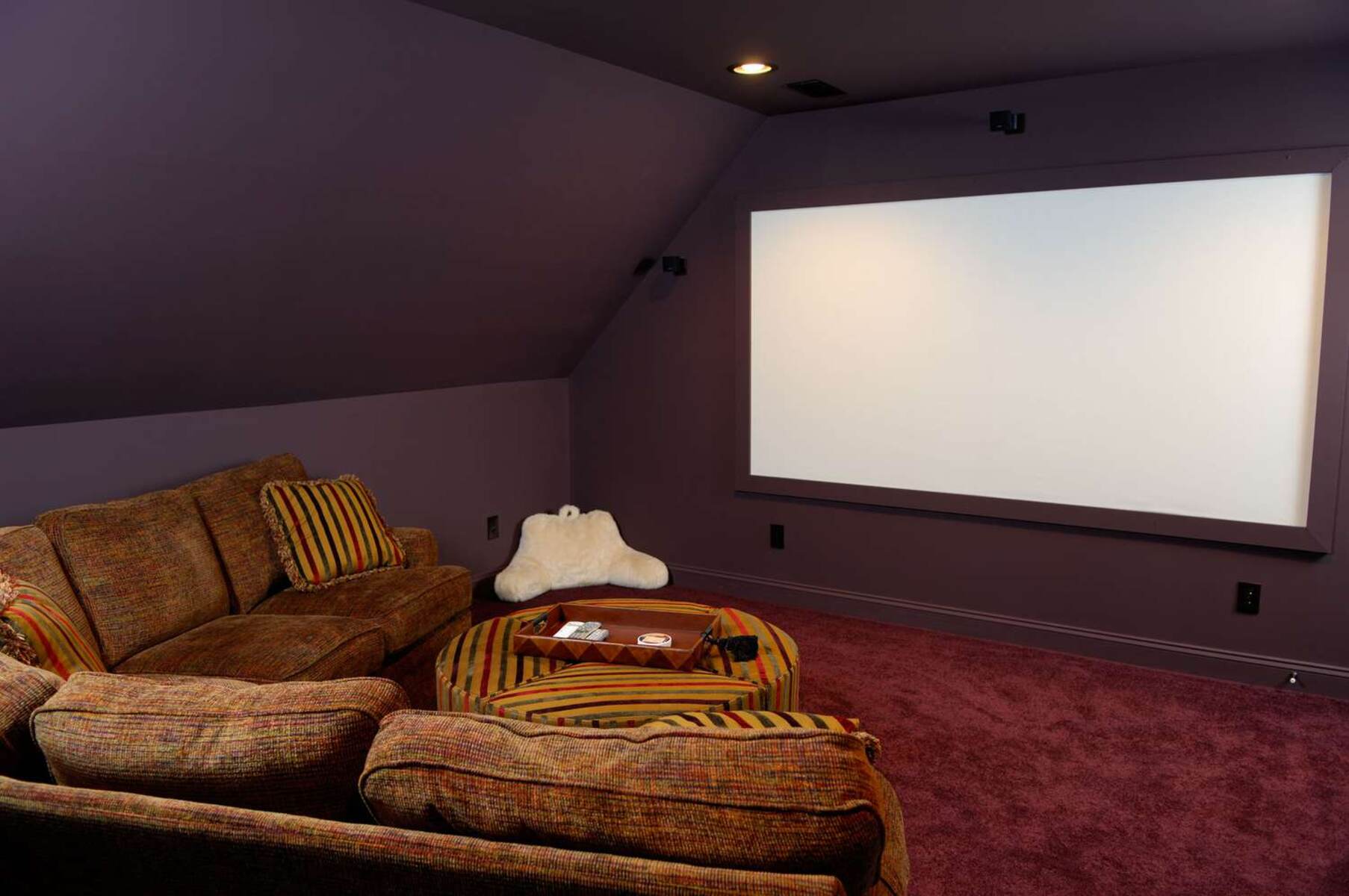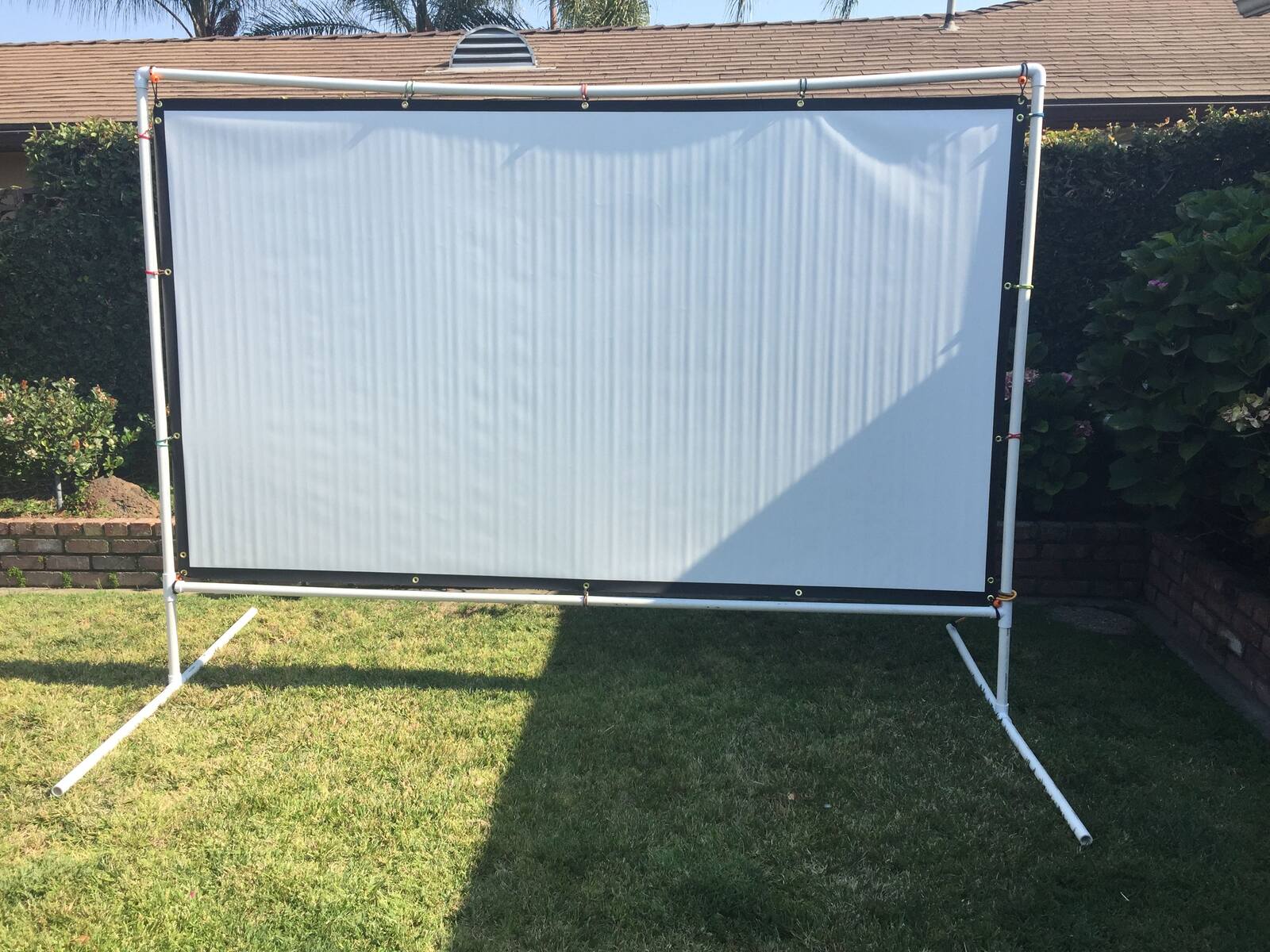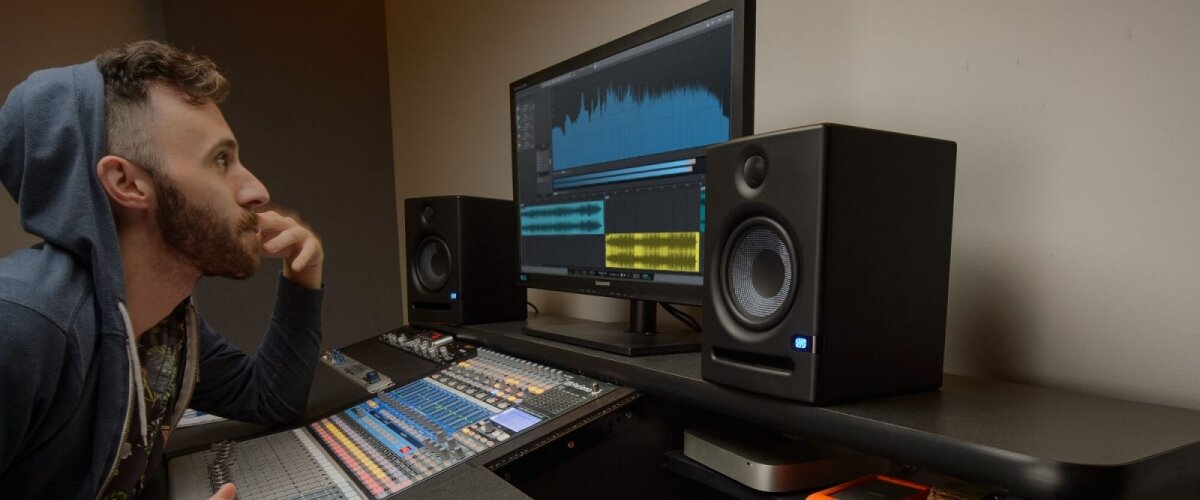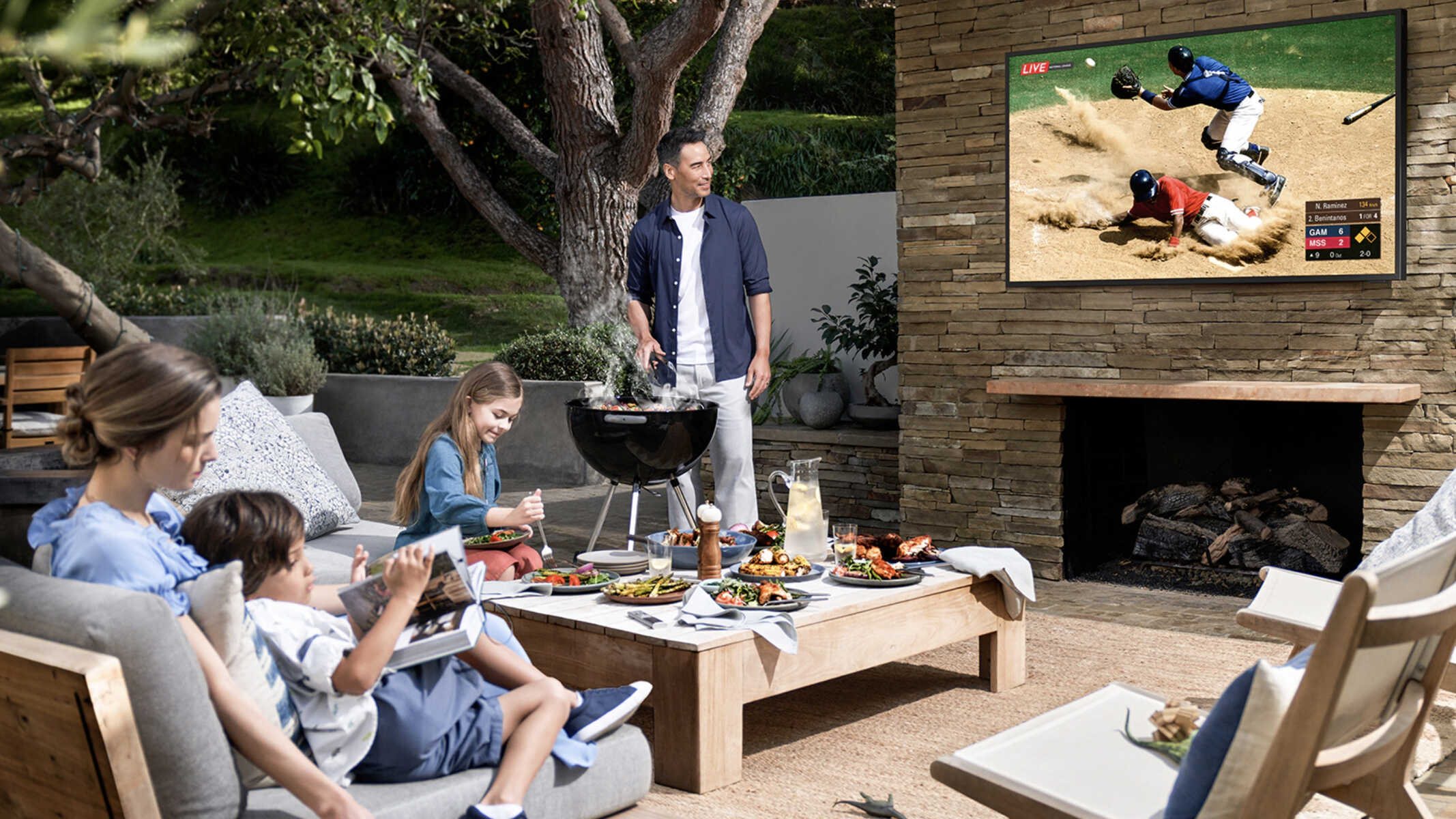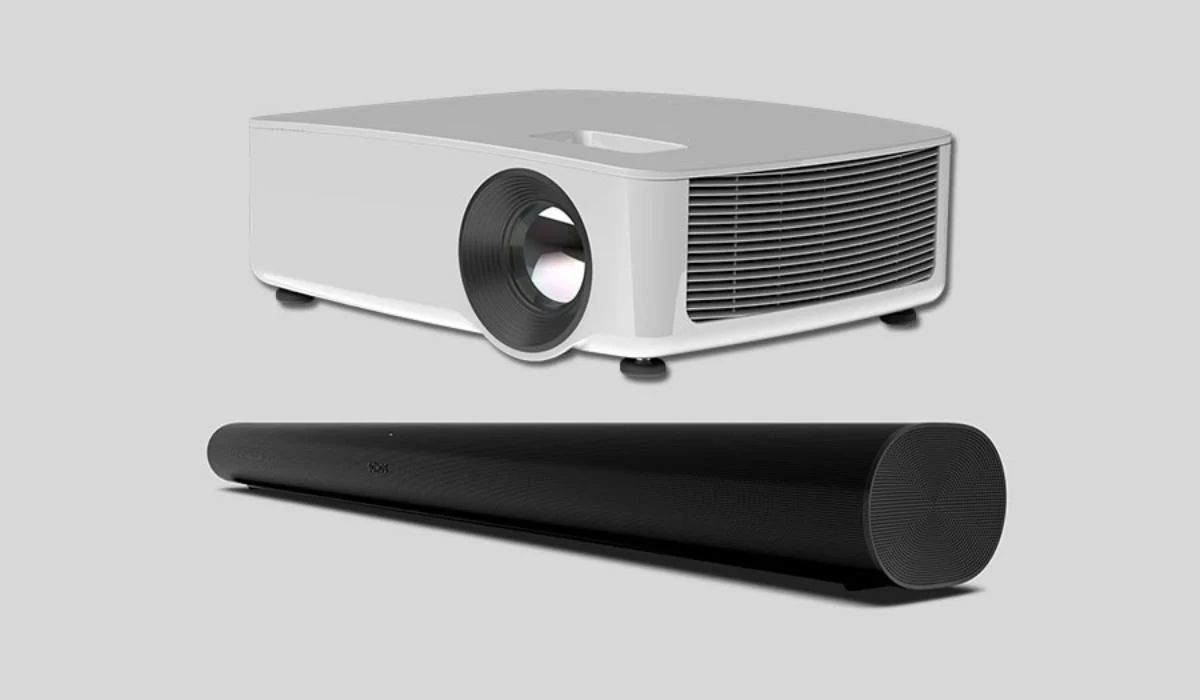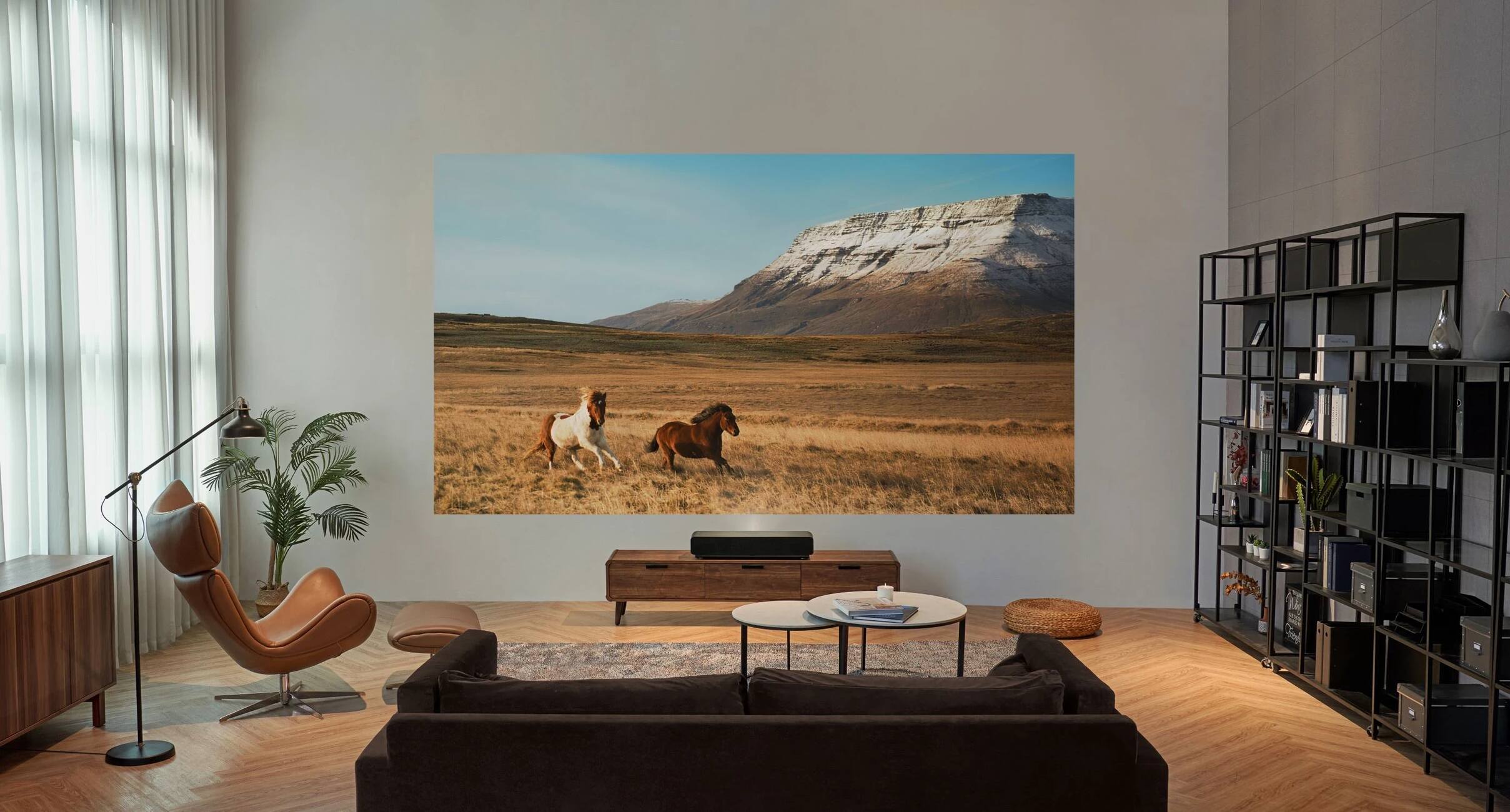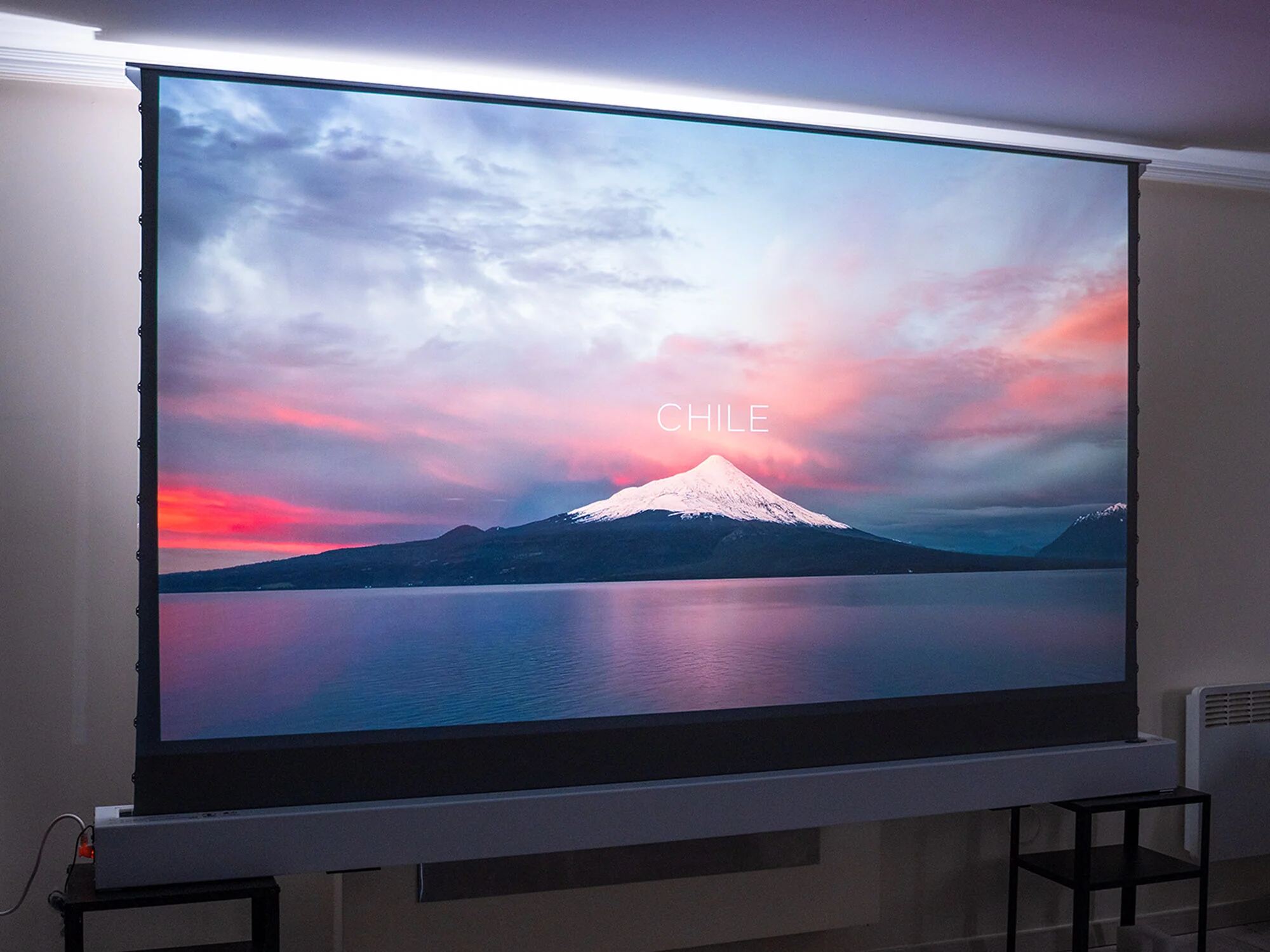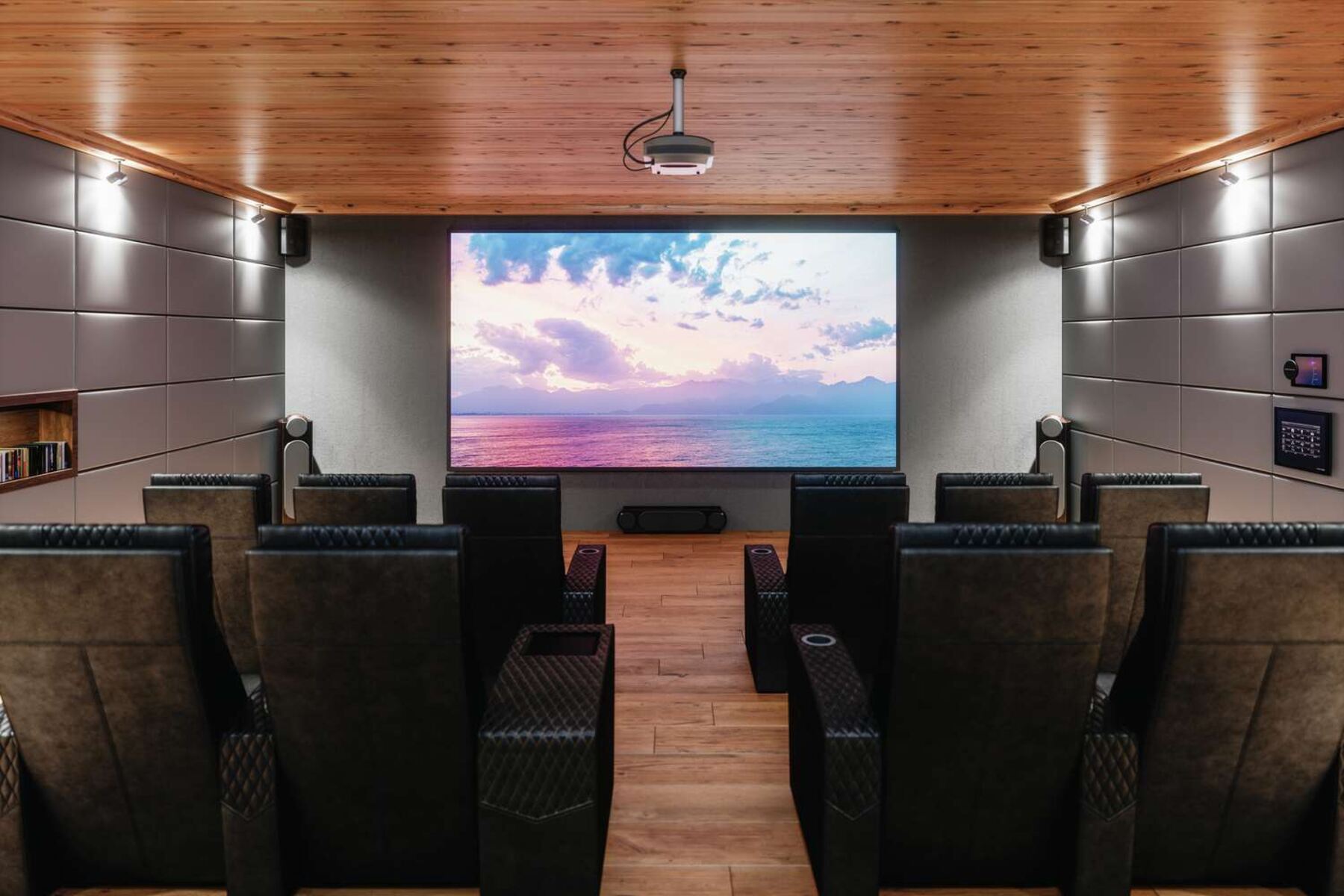Introduction
Welcome to the world of home theater systems, where immersive audio and stunning visuals come together to create an unparalleled cinematic experience. If you have a projector and are looking to enhance the sound quality of your movie nights, you may be wondering how to connect a soundbar to your projector.
A soundbar is a slim, elongated speaker system that is designed to provide high-quality audio and simulate multi-channel surround sound. It is a popular choice for those who want to improve the sound of their TVs, but did you know that you can also connect a soundbar to a projector?
A projector, on the other hand, is a device that projects an image onto a screen or a flat wall, allowing you to enjoy movies, TV shows, and even presentations on a larger scale. While projectors are known for their impressive visuals, the built-in speakers often fall short when it comes to delivering immersive audio.
By connecting a soundbar to your projector, you can elevate your home theater experience by achieving a more balanced and immersive audio-visual setup. In this guide, we will take you through the necessary steps to hook up your soundbar to your projector, as well as troubleshoot common issues and provide tips for optimizing performance.
Whether you enjoy watching movies, gaming, or hosting movie nights with friends and family, connecting a soundbar to your projector can take your entertainment to the next level. So, let’s dive in and explore how you can easily hook up your soundbar to your projector.
What is a Soundbar?
A soundbar is a sleek and compact audio device that is designed to improve the sound quality of your entertainment setup, be it a TV, projector, or audio system. It is a single speaker enclosure that consists of multiple built-in speakers and amplifiers to deliver powerful and immersive audio.
Unlike traditional speaker setups that require multiple speakers placed strategically around the room, a soundbar simplifies the installation process by offering a convenient all-in-one solution. It is typically placed below or above the TV or projector screen and can be wall-mounted or placed on a stand.
Soundbars come in various sizes and configurations, ranging from basic models that offer stereo sound to more advanced models that utilize virtual surround sound technology to create the illusion of a multi-channel audio setup. Many soundbars also feature built-in subwoofers or offer the option to add one for enhanced bass performance.
One of the key advantages of a soundbar is its ability to provide a wider soundstage and clearer dialogue, enhancing your overall audio experience. With its compact design, a soundbar seamlessly blends into any home theater setup without taking up excessive space or creating clutter.
Most soundbars connect to audio sources, such as TVs or projectors, through either an HDMI, optical, or RCA connection. Some models also offer wireless connectivity options like Bluetooth or Wi-Fi, allowing you to stream music from your smartphone or other compatible devices.
Overall, a soundbar is a versatile audio solution that brings a new level of audio immersion, whether you are watching movies, playing games, or listening to music. Now that you are familiar with the concept of a soundbar, let’s move on to understanding what a projector is.
What is a Projector?
A projector is a device that projects images or videos onto a screen or a flat surface, creating a larger-than-life visual experience. It uses a light source, typically a lamp or LED, to illuminate an image and a lens system to project it onto a surface. Projectors are commonly used in home theaters, classrooms, conference rooms, and even outdoor settings for various purposes.
Projectors come in different types, including LCD (Liquid Crystal Display), DLP (Digital Light Processing), and LCoS (Liquid Crystal on Silicon). Each type has its advantages and disadvantages, but they all aim to provide high-quality and immersive visuals.
One of the key benefits of a projector is its ability to create a large screen experience without requiring a large television panel. With a projector, you can enjoy movies, TV shows, sports events, and even video games on a screen that can span from 60 inches to well over 100 inches, making it ideal for recreating the cinematic experience in the comfort of your own home.
Projectors have various input options, including HDMI, VGA, and USB, allowing you to connect them to different devices such as Blu-ray players, gaming consoles, laptops, and, of course, soundbars. Many projectors also offer built-in speakers, but they are often not sufficient to deliver the immersive audio experience that complements the stunning visuals.
By connecting a soundbar to your projector, you can enhance your home theater setup by providing high-quality audio that matches the larger-than-life visuals. Whether you are enjoying an action-packed movie, cheering on your favorite sports team, or immersing yourself in the world of gaming, a projector combined with a soundbar creates a captivating and immersive entertainment experience.
Now that you have a better understanding of what a projector is and how it complements a soundbar, let’s move on to the benefits of connecting a soundbar to a projector.
Benefits of Connecting a Soundbar to a Projector
When it comes to creating a true cinematic experience at home, the combination of a projector and a soundbar offers several benefits that enhance your audio-visual setup. Let’s explore the advantages of connecting a soundbar to a projector:
1. Enhanced Audio Quality: While projectors are known for their impressive visuals, their built-in speakers often lack the power and clarity required to deliver an immersive audio experience. By connecting a soundbar, you can enjoy high-quality audio with improved soundstage, clearer dialogue, and enhanced bass, bringing your favorite movies, TV shows, and games to life.
2. Simplicity and Space Saving: Soundbars offer a convenient all-in-one audio solution that eliminates the need for multiple speakers placed around the room. They are designed to be sleek and compact, allowing you to save space and maintain a clean and clutter-free home theater setup.
3. Flexible Placement: Soundbars can be easily mounted below or above the projector screen or placed on a stand. Unlike traditional speaker setups that require precise positioning for optimal sound distribution, soundbars offer flexibility in placement without compromising audio quality.
4. Seamless Integration: Most soundbars feature multiple connectivity options, including HDMI, optical, or RCA, making it easy to connect them to your projector. This seamless integration ensures that your audio and video components work together seamlessly, simplifying the setup process and avoiding compatibility issues.
5. Immersive Movie Nights: The combination of a projector and a soundbar creates a captivating cinematic experience in the comfort of your own home. Whether you’re watching action-packed scenes, dramatic moments, or thrilling adventures, the enhanced audio quality adds depth and realism, immersing you in the on-screen action.
6. Gaming Experience: If you’re an avid gamer, connecting a soundbar to your projector can level up your gaming experience. The immersive audio provided by the soundbar enhances the atmosphere, allowing you to hear every detail, from footsteps to explosions, providing a more immersive and engaging gaming session.
7. Versatility: In addition to enhancing your movie and gaming experiences, a soundbar can also serve as a versatile audio device for other purposes. You can stream music from your smartphone or other compatible devices via Bluetooth or Wi-Fi, instantly transforming your projector setup into a wireless audio system for parties or casual listening.
By connecting a soundbar to your projector, you unlock a world of audio possibilities, elevating your home theater experience and ensuring that you see and hear every detail with clarity and depth.
Necessary Equipment for Connecting a Soundbar to a Projector
To successfully connect a soundbar to a projector, you will need a few essential equipment and cables. Here’s a list of the necessary items:
1. Soundbar: Of course, you will need a soundbar itself. Choose a soundbar that suits your audio needs, considering factors like audio quality, connectivity options, and size to ensure compatibility with your projector setup.
2. Projector: A projector is the primary device that displays the visuals on a screen or wall. Make sure you have a functioning projector that supports audio output, either through built-in speakers or audio output ports.
3. HDMI cable: HDMI cables are commonly used to transmit both audio and video signals. Check if your projector and soundbar have HDMI ports, and use a high-speed HDMI cable to connect the two devices. This ensures the best audio quality and simplifies the setup process.
4. Optical cable: If your projector and soundbar don’t have HDMI ports or if you prefer an alternative connection option, an optical cable can be used. The optical cable transmits audio signals in a digital format, ensuring high-quality sound transmission between the devices.
5. RCA cable: Another option for connecting your soundbar to your projector is using RCA cables. RCA cables are color-coded (red and white) and typically connect to the audio output ports on both devices. This analog connection method may not provide the highest audio quality but can still be suitable for basic setups.
6. Power cables: Ensure that both your soundbar and projector are connected to a power source using their respective power cables. This ensures that both devices receive the necessary power to function properly.
7. Mounting accessories (optional): If you plan to mount your soundbar and projector, you may need additional mounting accessories like brackets, screws, or mounting kits. These accessories vary depending on the soundbar and projector models, so refer to the manufacturer’s instructions or consult a professional for proper installation.
Before purchasing any cables or equipment, double-check the audio output options on your projector and the input options on your soundbar. Make sure they are compatible and have the necessary ports for a seamless connection.
Now that you have gathered the necessary equipment, let’s dive into the step-by-step guide of hooking up your soundbar to your projector.
Step-by-Step Guide to Hooking a Soundbar to a Projector
Connecting a soundbar to a projector is a straightforward process. Follow these steps to hook up your soundbar to your projector:
Step 1: Determine the Connections: Identify the available audio output options on your projector and the input options on your soundbar. Common options include HDMI, optical, and RCA. It’s best to use an HDMI connection for the highest audio quality, if both your projector and soundbar have HDMI ports.
Step 2: Power Off: Ensure both the soundbar and the projector are turned off and unplugged from the power source to prevent any electrical accidents or damage during the setup process.
Step 3: Connect HDMI or Optical Cable: If you are using an HDMI connection, connect one end of the HDMI cable to the HDMI ARC (Audio Return Channel) or audio output port on the projector and the other end to the HDMI ARC or audio input port on the soundbar. If you are using an optical cable, connect one end to the optical audio output port on the projector and the other end to the optical audio input port on the soundbar. Ensure the connections are secure.
Step 4: Connect Power Cables: Plug both the soundbar and the projector back into the power source using their respective power cables. Ensure they are securely connected and turned on.
Step 5: Select Audio Output: On your projector, go to the settings menu and navigate to the audio settings. Select the appropriate audio output option, such as HDMI or optical, depending on the type of connection you made.
Step 6: Configure Soundbar Settings: On your soundbar, check if it has any input selection options. If needed, select the input option that corresponds to the port you connected the projector to (e.g., HDMI or optical).
Step 7: Test the Audio: Play some audio or video content on your projector to test if the soundbar is receiving the audio signal. Adjust the volume levels on both the projector and the soundbar to ensure balanced audio output. Ensure that the soundbar is producing sound according to your preferences.
Step 8: Fine-tune Audio Settings (Optional): If needed, adjust the audio settings on the soundbar to optimize the sound output. You may have options like eq
ualizer presets, sound modes, or bass/treble adjustments. Experiment with these settings to personalize the audio experience.
Following these steps will ensure a successful connection between your soundbar and projector, providing you with enhanced audio quality for your projector setup.
Now that you have hooked up your soundbar to your projector, let’s address some common issues you may encounter and how to troubleshoot them.
Troubleshooting Common Issues
While connecting a soundbar to a projector is relatively straightforward, you may encounter some common issues. Here are a few troubleshooting steps to resolve these issues:
No Sound: If you don’t hear any sound coming from the soundbar, ensure that you have selected the correct audio output on the projector. Make sure the volume on both the soundbar and the projector is turned up. Check the cables for firm connections and ensure they are securely plugged into the correct ports. Additionally, ensure that the soundbar is powered on and set to the correct input source.
Poor Audio Quality: If you experience distorted or poor audio quality, verify that the cables are high-quality and undamaged. Ensure that you have selected the proper audio settings on both the projector and the soundbar. Adjust the soundbar’s equalizer settings or sound modes to find the best audio output for your preferences.
No HDMI ARC Support: If your soundbar or projector does not have HDMI ARC (Audio Return Channel) support, you may need to use an optical or RCA connection instead. Make sure to select the corresponding audio output option on the projector and the correct input option on the soundbar.
No Audio Output from Scenes or Applications: Some projectors have a sleep or mute mode that may impact audio output. Check the projector’s settings and disable any audio-related sleep or mute functions. Additionally, ensure that the media or application you are using has audio enabled and the volume is not muted within the content itself.
Compatibility Issues: Ensure that the soundbar and the projector are compatible with each other in terms of audio formats and connections. Review the user manuals or contact the manufacturer’s support for any specific compatibility guidelines or recommendations.
If none of these troubleshooting steps resolve the issues, consider double-checking the user manuals for both devices or consulting the manufacturer’s support for further assistance.
Now that you’re equipped with troubleshooting knowledge let’s move on to some tips for optimizing the performance of your soundbar and projector setup.
Tips for Optimizing Soundbar and Projector Performance
To ensure the best audio-visual experience with your soundbar and projector setup, consider implementing the following tips to optimize their performance:
1. Room Acoustics: Pay attention to the acoustics of your room. Reducing ambient noise and echo will enhance the sound quality. Use rugs, curtains, or acoustic panels to absorb sound reflections and create a more controlled listening environment.
2. Speaker Placement: Position your soundbar in an optimal location, either below or above the projector screen. Avoid obstructing the soundbar with objects and ensure it is centered with the projector. Experiment with speaker placement to find the best balance between audio projection and aesthetic appeal.
3. Subwoofer Placement (If applicable): If your soundbar has a separate subwoofer, experiment with different placements to find the best position for deep bass response. Typically, placing the subwoofer near a corner or against a wall can help enhance bass performance.
4. Calibration and Audio Settings: Use the soundbar’s built-in calibration tools or utilize an audio calibration app to fine-tune the audio settings. Adjust parameters like equalizer presets, sound modes, and individual speaker levels to achieve the desired sound quality for different types of media.
5. Projector Placement: Ensure that the projector is properly aligned and positioned according to the screen or wall surface. Follow the projector’s guidelines for the optimal distance and angle to achieve the desired image size and clarity. Adjust the projector settings, such as brightness, contrast, and color, to achieve the best visual performance.
6. Screen or Wall Surface: Consider using a high-quality projector screen or a smooth, flat wall surface for the best image projection. It should have good reflectivity and minimal texture or imperfections to ensure optimal image quality. Avoid projecting onto surfaces with excessive texture or roughness that can scatter the light.
7. Lighting Control: Adequate lighting control is crucial for optimal projector performance. Minimize ambient light by using blackout curtains or blinds to create a dark environment. If necessary, invest in lighting fixtures with adjustable brightness levels to provide subtle and indirect lighting while avoiding direct light on the projection surface.
8. Regular Maintenance: Keep both the soundbar and projector clean and free from dust or debris. Regularly check and clean the projector’s air filters to ensure proper airflow and prevent overheating, which can affect performance and longevity.
9. Firmware and Software Updates: Check for firmware or software updates for both the soundbar and the projector. Updating to the latest versions can improve performance, fix bugs, and provide access to new features and optimizations.
10. Seek Professional Help: If you are encountering persistent issues or want to maximize the performance of your soundbar and projector setup, consider consulting a professional installer or seeking technical support from the manufacturers. They can provide expert guidance and assistance tailored to your specific setup.
By implementing these tips, you can enhance the performance of your soundbar and projector, delivering a truly immersive audio-visual experience for all your entertainment needs.
Conclusion
Connecting a soundbar to your projector opens up a world of possibilities for your home theater setup. By combining the stunning visuals of a projector with the enhanced audio quality of a soundbar, you can create a truly immersive cinematic experience right in your own living room.
In this guide, we’ve explored what a soundbar and a projector are, the benefits of connecting them, the necessary equipment for the connection, and a step-by-step guide to hooking them up. We’ve also provided troubleshooting tips to address common issues and strategies for optimizing the performance of your soundbar and projector setup.
Remember to pay attention to room acoustics, speaker and subwoofer placement, calibration and audio settings, as well as projector placement and lighting control. Keep both the soundbar and projector clean and updated, and don’t hesitate to seek professional help when needed.
Whether you’re watching movies, enjoying gaming sessions, or hosting a movie night with loved ones, the combination of a soundbar and projector creates a captivating audio-visual experience. So, gather your favorite snacks, dim the lights, and immerse yourself in the world of entertainment with your newly connected soundbar and projector.
Now, it’s time to sit back, relax, and enjoy an incredible home theater experience like never before.







